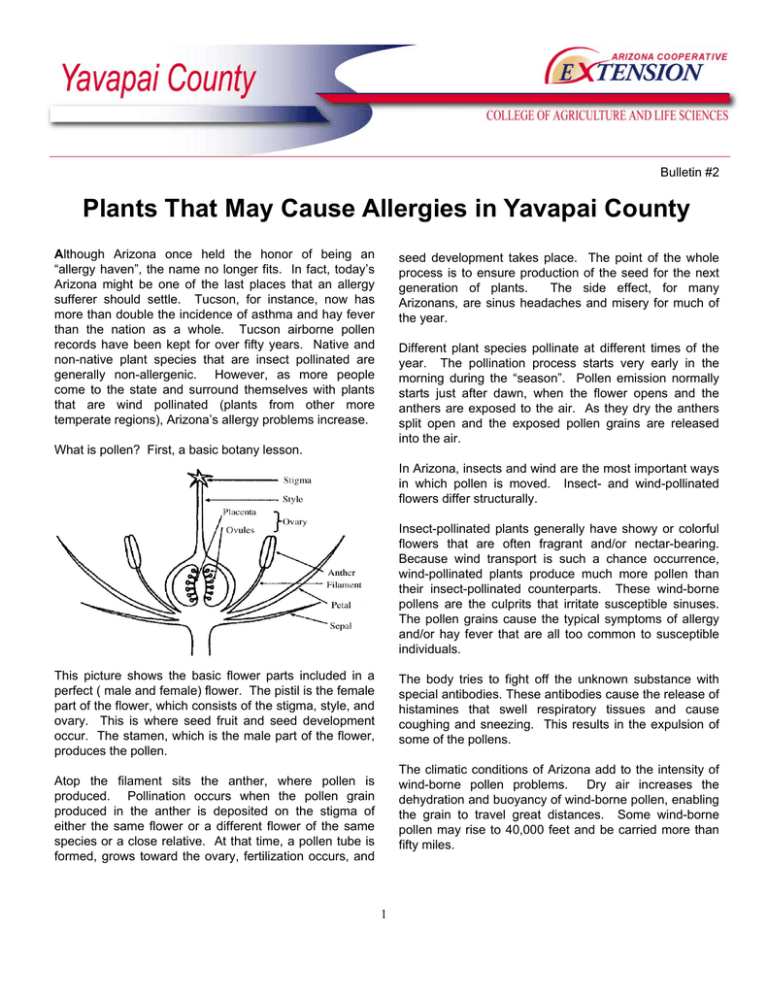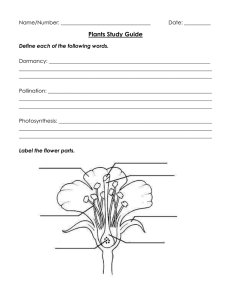Plants That May Cause Allergies
advertisement

Bulletin #2 Plants That May Cause Allergies in Yavapai County Although Arizona once held the honor of being an “allergy haven”, the name no longer fits. In fact, today’s Arizona might be one of the last places that an allergy sufferer should settle. Tucson, for instance, now has more than double the incidence of asthma and hay fever than the nation as a whole. Tucson airborne pollen records have been kept for over fifty years. Native and non-native plant species that are insect pollinated are generally non-allergenic. However, as more people come to the state and surround themselves with plants that are wind pollinated (plants from other more temperate regions), Arizona’s allergy problems increase. seed development takes place. The point of the whole process is to ensure production of the seed for the next generation of plants. The side effect, for many Arizonans, are sinus headaches and misery for much of the year. Different plant species pollinate at different times of the year. The pollination process starts very early in the morning during the “season”. Pollen emission normally starts just after dawn, when the flower opens and the anthers are exposed to the air. As they dry the anthers split open and the exposed pollen grains are released into the air. What is pollen? First, a basic botany lesson. In Arizona, insects and wind are the most important ways in which pollen is moved. Insect- and wind-pollinated flowers differ structurally. Insect-pollinated plants generally have showy or colorful flowers that are often fragrant and/or nectar-bearing. Because wind transport is such a chance occurrence, wind-pollinated plants produce much more pollen than their insect-pollinated counterparts. These wind-borne pollens are the culprits that irritate susceptible sinuses. The pollen grains cause the typical symptoms of allergy and/or hay fever that are all too common to susceptible individuals. This picture shows the basic flower parts included in a perfect ( male and female) flower. The pistil is the female part of the flower, which consists of the stigma, style, and ovary. This is where seed fruit and seed development occur. The stamen, which is the male part of the flower, produces the pollen. The body tries to fight off the unknown substance with special antibodies. These antibodies cause the release of histamines that swell respiratory tissues and cause coughing and sneezing. This results in the expulsion of some of the pollens. The climatic conditions of Arizona add to the intensity of wind-borne pollen problems. Dry air increases the dehydration and buoyancy of wind-borne pollen, enabling the grain to travel great distances. Some wind-borne pollen may rise to 40,000 feet and be carried more than fifty miles. Atop the filament sits the anther, where pollen is produced. Pollination occurs when the pollen grain produced in the anther is deposited on the stigma of either the same flower or a different flower of the same species or a close relative. At that time, a pollen tube is formed, grows toward the ovary, fertilization occurs, and 1 Plants That May Cause Allergies in Yavapai County Bulletin #2 • One of our most abundant native plants -- the juniper-produces wind-borne pollen. Juniperus scopulorus and J. monosperma release their pollen in February and March. Other native weeds, including carelessweed (Amaranthus palmeria) and ragweed (Ambrosia aptera) produce allergenic pollen also. You can’t do anything about the native pollens that are produced. Beware of using plant species from other climate zones, as they may cause further allergy problems. Morus alba, fruitless mulberry, is considered by some to be another significant offender. This tree was introduced from a more temperate zone and was commonly planted for its dense shade and heat tolerance. The mulberry produces male and female flowers on separate trees. The male, fruitless but pollen-full, was once considered an excellent alternative to the messy fruit of the female tree. Allergy sufferers now believe that it causes more problems than it solves. Some Allergy Offenders in Yavapai County Electron micrograph of a Juniperus pollen grain. In the past, many people moved to Arizona to escape allergy problems elsewhere. In trying to make the landscape seem a little more hospitable, they often planted the very plants that are the primary cause of pollen pollution. This trend of planting introduced ornamentals from temperate zones continues today. It is now suspected that sheer volume may affect allergy sufferers. That is, the over-use of one grass, shrub or tree species in the landscape may lead to that plant becoming an important allergen. The use of varied landscape plants has long been recommended for pest and disease prevention; it may now serve as allergy protection as well. Two plants are considered the primary allergy offenders in central Arizona. • Cynodon dactylon, common bermuda grass, is possibly the worst offender; bermuda grass contributes almost twice as much pollen to the daily pollen count as any other plant. It may flower several times throughout the growing season, and can cause allergy problems from spring through fall. Common Name Latin Name High Pollen Months Arizona Cypress Cupressus arizonica October—April Ash Fraxinus sp. March—May Careless weed Amaranthus palmeri April—October Common bermuda grass Cynodon dactylon June—September Elm Ulmus sp February—April European olive Olea europa March—May Fountain grass Pennisetum setaceum September Fruitless mulberry Morus alba February—March Johnson grass Sorghum halapense May—December Juniper Juniperus spp. February, March—April Mesquite Prosopsis juliflora March—August Oak Quercus sp March—June Pampas grass Cortaderia selloana March—May Pecan Carya pecan February—April Privet Ligustrum lucidum April—June Ragweed Ambrosia aptera July—October Russian Thistle Salsola kali May—November Salt cedar Tamarix March—September Tree of Heaven Alianthus altissima April—June Updated August 1, 2007 http://cals.arizona.edu/yavapai The University of Arizona is an equal opportunity, affirmative action institution. The University does not discriminate on the basis of race, color, religion, national origin, age, disability, veteran status, or sexual orientation in its programs and activities. 2



